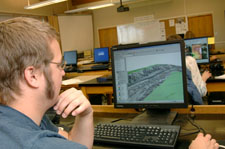Accessibility is different than Usability. In the context of electronic documents, usability refers to the ease and efficiency users experience interacting with electronic documents. Accessibility usually refers to how well persons with disabilities can interact with an electronic document. For many people, including those with reading disorders, visual disabilities, motoric or neurological disabilities inaccessible documents present significant obstacles to learning and efficient work that are not present for those without disabilities.

“The policy of the CSU is to make its programs, services, and activities accessible to students, faculty, staff, and the general public who visit or attend a campus-sponsored event, with disabilities.”(Executive Order 926 12/20/04)
The Chancellor's office Coded Memo AA-2007-04 is essentially a roadmap for ensuring accessibility within the CSU in accordance with federal and state laws mandates and CSU policy. The Accessible Technology Initiative lays out a timeline with benchmarks leading to full compliance by the year 2012. By that date all electronic information sources including web pages, instructional materials, and electronic equipment procurement comply with standards to insure accessibility for all students including those students with disabilities.
This is a far reaching mandate that encourages the concept of "Universal Design for Learning" in which accessibility is considered in the design phase of instruction, electronic information dissemination, and the purchase of electronic equipment. It will require the active participation of all members and segments of our campus community to be actively involved.
A large task force group made up of individuals representing faculty, staff and administration has been hard at work developing the comprehensive plans required to meet first year benchmarks. In this second year, developing and implementing the training necessary to fulfill second year benchmarks is the current priority of each sub-committee. More information will be provided as specific training programs become ready for access.
There is an informational web site attached to the Main HSU homepage under “A” for “Accessible Technology Initiative.” A tremendous amount of information is listed there including Frequently Asked Questions (FAQs) and Helpful Links. Check out our web page. The address is: www.humboldt.edu/~ati.